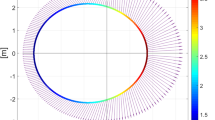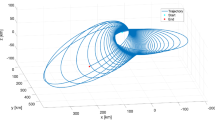Abstract
An analysis is presented of the orbital injection errors for the Lageos III satellite mission. Several methods are introduced for the solution of the Inverse Problem in the Theory of Errors. The novelty of the present approach consists in the use of the full geopotential covariance matrix in the error propagation equations. The GEM-T1 covariance matrix is used. It is found that by properly accounting for the correlation among the even zonal harmonic coefficients the acceptable error bounds increase by an order of magnitude with respect to the case when only the variances are used. The most stringent constraint, even when using the full covariance, is on inclination, whose nominal value must be realized within approximately 0.1° for the recovery of the Lense-Thirring precession to be successful at the 3% level (accounting only for injection errors). The associated tolerance in the semimajor axis is about 30 km while that in eccentricity is approximately 0.2. However, if the errors in semimajor axis and eccentricity can be kept to the routinely achievable levels respectively of 10 km and 0.004, then the tolerance in inclination can be relaxed to 0.2°.
Similar content being viewed by others
References
Brouwer, D. and Clemence, G.M.: 1961,Methods of Celestial Mechanics, Academic Press, New York.
Caputo, M.: 1967,The Gravity Field of the Earth from Classical and Modern Methods, Academic Press, New York.
Casotto, S. and Ciufolini, I.: 1987, ‘Injection Erros’, in: B. Bertotti and I. Ciufolini (eds.),An Experiment to Measure the Gravitomagnetic Force with Laser Ranged Satellites, A mission definition study for the ItalianPiano Spaziale Nazionale.
Ciufolini, I.: 1986, ‘Measurement of the Lense-Thirring Drag on High-Altitude, Laser-Ranged Artificial Satellites’,Phys. Rev. Lett. 56, 278–281.
Ciufolini, I.: 1989, ‘A Comprehensive Introduction to the Lageos Gravitomagnetic Experiment: from the Importance of the Gravitomagnetic Field in Physics to Preliminary Error Analysis and Error Budget’,Int. J. Mod. Phys. 4, 3083–3145.
Kaula, E.: 1966,Theory of Satellite Geodesy, Blaisdell, Waltham, Massachusetts.
Lense, J. and Thirring, H.: 1918, ‘Über den Einfluss der Eigenrotation der Zentralkorper auf die Bewegung der Planeten und Monde nach der Einsteinschen Gravitationstheorie’,Phys. Z. 19, 156–163; English translation in: B. Mashhoon, F.W. Hehl and D.S. Theiss,Gen. Relativ. Gravit. 16, 711–741 (1984).
Marsh, J.G., Lerch, F.J., Putney, B.H., Christodoulidis, D.C., Smith, D.E., Felsentreger, T.L., Sanchez, B.V., Klosko, S.M., Pavlis, E.C., Martin, T.V., Robbins, J.W., Williamson, R.G., Colombo, O.L., Rowlands, D.D., Eddy, W.F., Chandler, N.L., Rachlin, K.E., Patel, G.B., Bhati, S. and Chinn, D.S.: 1988, ‘A New Gravitational Model for the Earth from Satellite Tracking Data: GEM-T1’,JGR 93 (B6), 6169.
Shchigolev, B.M.: 1965,Mathematical Analysis of Observations, American Elsevier, New York.
Author information
Authors and Affiliations
Rights and permissions
About this article
Cite this article
Casotto, S. Orbit injection error analysis for the Lageos III mission. Celestial Mech Dyn Astr 56, 397–408 (1993). https://doi.org/10.1007/BF00691810
Received:
Accepted:
Issue Date:
DOI: https://doi.org/10.1007/BF00691810




